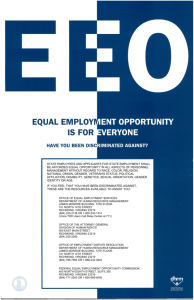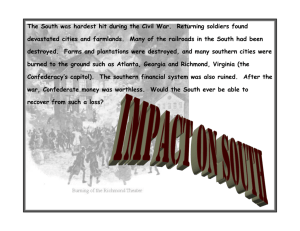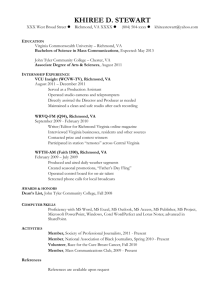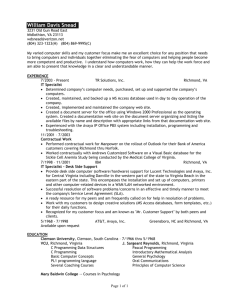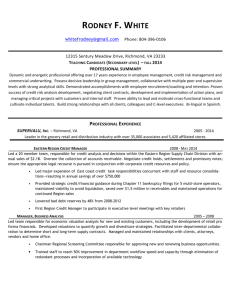McEachran PPT
advertisement
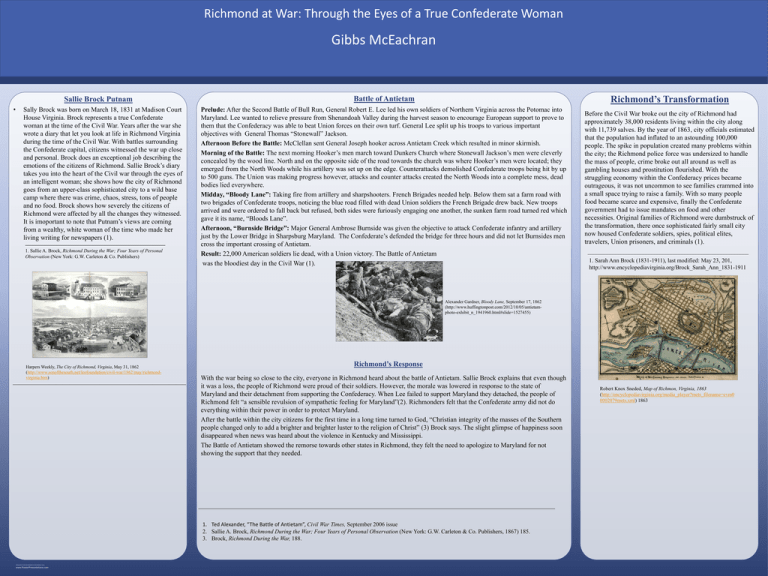
Richmond at War: Through the Eyes of a True Confederate Woman Gibbs McEachran Sallie Brock Putnam • Sally Brock was born on March 18, 1831 at Madison Court House Virginia. Brock represents a true Confederate woman at the time of the Civil War. Years after the war she wrote a diary that let you look at life in Richmond Virginia during the time of the Civil War. With battles surrounding the Confederate capital, citizens witnessed the war up close and personal. Brock does an exceptional job describing the emotions of the citizens of Richmond. Sallie Brock’s diary takes you into the heart of the Civil war through the eyes of an intelligent woman; she shows how the city of Richmond goes from an upper-class sophisticated city to a wild base camp where there was crime, chaos, stress, tons of people and no food. Brock shows how severely the citizens of Richmond were affected by all the changes they witnessed. It is imoportant to note that Putnam’s views are coming from a wealthy, white woman of the time who made her living writing for newspapers (1). ___________________________________ 1. Sallie A. Brock, Richmond During the War; Four Years of Personal Observation (New York: G.W. Carleton & Co. Publishers) Richmond’s Transformation Battle of Antietam Prelude: After the Second Battle of Bull Run, General Robert E. Lee led his own soldiers of Northern Virginia across the Potomac into Maryland. Lee wanted to relieve pressure from Shenandoah Valley during the harvest season to encourage European support to prove to them that the Confederacy was able to beat Union forces on their own turf. General Lee split up his troops to various important objectives with General Thomas “Stonewall” Jackson. Afternoon Before the Battle: McClellan sent General Joseph hooker across Antietam Creek which resulted in minor skirmish. Morning of the Battle: The next morning Hooker’s men march toward Dunkers Church where Stonewall Jackson’s men were cleverly concealed by the wood line. North and on the opposite side of the road towards the church was where Hooker’s men were located; they emerged from the North Woods while his artillery was set up on the edge. Counterattacks demolished Confederate troops being hit by up to 500 guns. The Union was making progress however, attacks and counter attacks created the North Woods into a complete mess, dead bodies lied everywhere. Midday, “Bloody Lane”: Taking fire from artillery and sharpshooters. French Brigades needed help. Below them sat a farm road with two brigades of Confederate troops, noticing the blue road filled with dead Union soldiers the French Brigade drew back. New troops arrived and were ordered to fall back but refused, both sides were furiously engaging one another, the sunken farm road turned red which gave it its name, “Bloods Lane”. Afternoon, “Burnside Bridge”: Major General Ambrose Burnside was given the objective to attack Confederate infantry and artillery just by the Lower Bridge in Sharpsburg Maryland. The Confederate’s defended the bridge for three hours and did not let Burnsides men cross the important crossing of Antietam. Result: 22,000 American soldiers lie dead, with a Union victory. The Battle of Antietam was the bloodiest day in the Civil War (1). Before the Civil War broke out the city of Richmond had approximately 38,000 residents living within the city along with 11,739 salves. By the year of 1863, city officials estimated that the population had inflated to an astounding 100,000 people. The spike in population created many problems within the city; the Richmond police force was undersized to handle the mass of people, crime broke out all around as well as gambling houses and prostitution flourished. With the struggling economy within the Confederacy prices became outrageous, it was not uncommon to see families crammed into a small space trying to raise a family. With so many people food became scarce and expensive, finally the Confederate government had to issue mandates on food and other necessities. Original families of Richmond were dumbstruck of the transformation, there once sophisticated fairly small city now housed Confederate soldiers, spies, political elites, travelers, Union prisoners, and criminals (1). __________________________________________________________ 1. Sarah Ann Brock (1831-1911), last modified: May 23, 201, http://www.encyclopediavirginia.org/Brock_Sarah_Ann_1831-1911 Alexander Gardner, Bloody Lane, September 17, 1862 (http://www.huffingtonpost.com/2012/10/05/antietamphoto-exhibit_n_1941960.html#slide=1527455) Harpers Weekly, The City of Richmond, Virginia, May 31, 1862 (http://www.sonofthesouth.net/leefoundation/civil-war/1862/may/richmondvirginia.htm) ____________________________________________________ Richmond’s Response With the war being so close to the city, everyone in Richmond heard about the battle of Antietam. Sallie Brock explains that even though it was a loss, the people of Richmond were proud of their soldiers. However, the morale was lowered in response to the state of Maryland and their detachment from supporting the Confederacy. When Lee failed to support Maryland they detached, the people of Richmond felt “a sensible revulsion of sympathetic feeling for Maryland”(2). Richmonders felt that the Confederate army did not do everything within their power in order to protect Maryland. After the battle within the city citizens for the first time in a long time turned to God, “Christian integrity of the masses of the Southern people changed only to add a brighter and brighter luster to the religion of Christ” (3) Brock says. The slight glimpse of happiness soon disappeared when news was heard about the violence in Kentucky and Mississippi. The Battle of Antietam showed the remorse towards other states in Richmond, they felt the need to apologize to Maryland for not showing the support that they needed. ___________________________________________________________________________________________________________ 1. Ted Alexander, “The Battle of Antietam”, Civil War Times, September 2006 issue 2. Sallie A. Brock, Richmond During the War; Four Years of Personal Observation (New York: G.W. Carleton & Co. Publishers, 1867) 185. 3. Brock, Richmond During the War, 188. RESEARCH POSTER PRESENTATION DESIGN © 2012 www.PosterPresentations.com Robert Knox Sneded, Map of Richmon, Virginia, 1863 (http://encyclopediavirginia.org/media_player?mets_filename=evm0 0002079mets.xml) 1863

